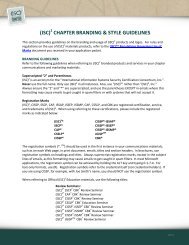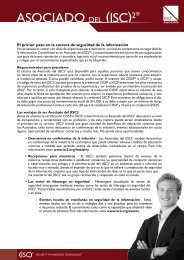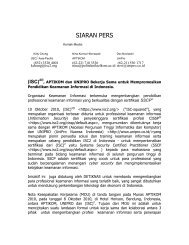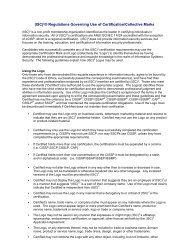Code (In)Security - ISC
Code (In)Security - ISC
Code (In)Security - ISC
Create successful ePaper yourself
Turn your PDF publications into a flip-book with our unique Google optimized e-Paper software.
Characteristics of <strong>In</strong>secure <strong>Code</strong><br />
Characteristic<br />
I<br />
N<br />
S<br />
E<br />
C<br />
U<br />
R<br />
E<br />
<strong>In</strong>jectable <strong>Code</strong><br />
Non-Repudiation Mechanisms not Present<br />
Spoofable <strong>Code</strong><br />
Exceptions and Errors not Properly Handled<br />
Cryptographically Weak <strong>Code</strong><br />
Unsafe/Unused Functions and Routines in <strong>Code</strong><br />
Reversible <strong>Code</strong><br />
Elevated Privileges Required to Run<br />
I - <strong>In</strong>jectable <strong>Code</strong><br />
<strong>In</strong>jectable code is code that makes the infamous and prevalent<br />
injection attacks possible, allowing the user-supplied data to be<br />
executed as code. There are various types of injection attacks:<br />
attacks against databases (e.g., SQL injection), attacks against<br />
directory structures (e.g., LDAP injection), and even attacks against<br />
the operating system itself (e.g., OS command injection). Improper<br />
validation or filtration leads to injectable code attacks.<br />
Lack of validation of user-supplied input is the primary reason why<br />
injection attacks are possible, resulting in serious consequences.<br />
Breaches such as the disclosure of sensitive information<br />
(confidentiality breach), tampering and manipulation of directory<br />
structures and trees (integrity breach), denial of service (availability<br />
breach), authentication and authorization check bypass, and even<br />
remote code execution are possible.<br />
Coding constructs that depend on the user-supplied data to<br />
build the queries to be executed in the backend on-the-fly<br />
(dynamically) is another possibility that should not be overlooked.<br />
There are many defensive coding techniques against injectable<br />
code. One option is input sanitization, which can be achieved<br />
either by allowing only a certain set of valid inputs, or disallowing<br />
and removing any invalid input patterns and characters.<br />
A second option is the use of parameterized queries, those that<br />
are not dynamically generated. These take the user-supplied input<br />
as parameters. When architected correctly, they also aid with<br />
performance. Coding standards should disallow the dynamic<br />
construction of queries in code to mitgate injection attacks and<br />
this must be enforced.<br />
2<br />
“All <strong>In</strong>put Data is Evil-So Make Sure You Handle It Correctly and<br />
with Due Care” c by Dino Esposito, published in CoDe magazine is<br />
a good reference article and as the latter half of the title rightfully<br />
suggests, it is extremely important to be able to identify injectable<br />
code and take necessary steps (due care) to address it.<br />
N - Non-Repudiation Mechanisms not Present<br />
<strong>In</strong> a highly interconnected and mobile world, it is imperative<br />
that the authenticity of code origin, and critical business and<br />
administrative transactions be indisputable. Non-repudiation is<br />
the guarantee that the origin of code is what it claims to be. It<br />
is the ability to verify the authenticity of the code’s origin. This is<br />
particularly important because code can be downloaded from<br />
a remote location and executed on a local system. Referred<br />
to as “mobile” code, it must carry proof of its origin to verify<br />
authenticity, which can be achieved by signing the code. <strong>Code</strong><br />
signing is the process of digitally signing code (executables, scripts<br />
etc.), to assure that the code has not been tampered with, and<br />
that the code is from a valid software publisher. <strong>Code</strong> signing is<br />
also known as digital shrink-wrapping.<br />
Non-repudiation also applies to ensuring that the actions taken<br />
by the code cannot be denied.<br />
Auditing functionality in code is a mechanism to ensure that<br />
repudiation is not possible. At a bare minimum, for critical business<br />
and administrative transactions, the code must be written to record<br />
the action taken, including the timestamp and other pertinent<br />
details such as the user or process that is performing the action.<br />
S – Spoofable <strong>Code</strong><br />
Spoofing is the act of impersonating another user or process.<br />
Spoofable code is code that allows for spoofing attacks. Spoofing<br />
attacks allow the impersonator to perform actions with the<br />
same level of trust as a valid user, who has been impersonated.<br />
Disclosure of information to unintended users, tampering with<br />
data, resource exhaustion, bypassing authentication, circumventing<br />
authorization checks, deletion or manipulation of audit logs are all<br />
potential consequences of spoofing.<br />
Spoofing has been observed in cases where the code base is not<br />
segmented to run under different execution contexts based on<br />
the trust (privilege) levels of the caller of the code. This violates<br />
the principle of “least common mechanism” which states that<br />
mechanisms common to more than one user/process are not<br />
shared d . With just one execution context for all code, an attacker<br />
can spoof an identity and execute the code as if the attacker was<br />
a valid user with permission.<br />
www.isc2.org

















